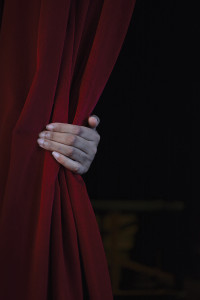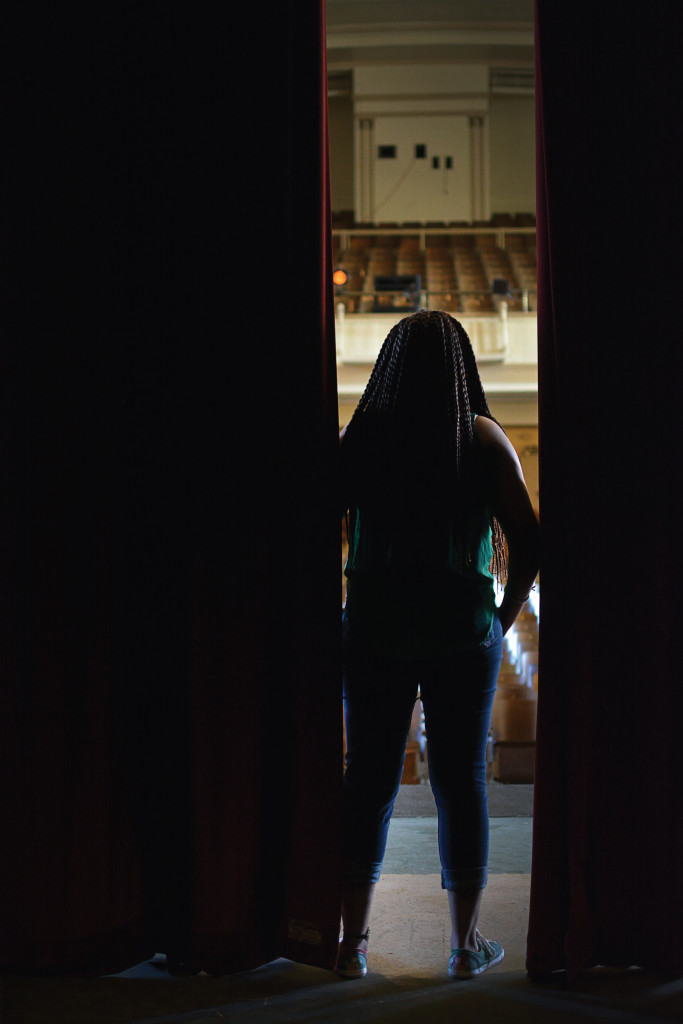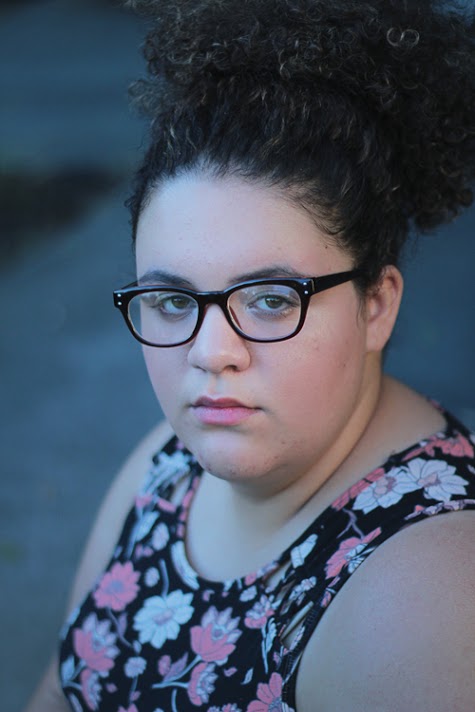Grant High administrators and teachers say they want the school’s theater Department to be more inclusive when it comes to race.
When is that going to happen?
[aesop_parallax img=”http://grantmagazine.com/wp-content/uploads/2016/08/giphy.gif” parallaxbg=”on” parallaxspeed=”1″ captionposition=”bottom-left” lightbox=”off” floater=”off” floaterposition=”left” floaterdirection=”up”]
Story by Sophie Hauth and Callie Quinn-Ward | Photos by Finn Hawley-Blue | Video by Mackie Mallison
In early 2015, Grant High School auditorium’s stage was adorned with a gray backdrop, framed by its signature red curtains. The set was a scene from a 17th century European home; a few chairs covered with a paisley print and a dresser also sit in the background for the play, “Tartuffe.”
The characters, nearly all white, were dressed in long printed dresses, pantaloons and tights. They spoke in British accents between laughs from the audience.
The show isn’t the only production that’s played out this way. In fact, it’s a pattern the Grant community has come to know well. Over the last six theater productions at the school, there have been more than 200 students who participated. Less than 40 have been students of color.
In the last few years, the play “Spamalot” had the greatest number of students of color that made up about 22 percent of the cast, which is significantly under Grant’s population of students of color. And only a few minority students had leading roles. When the Theater Department put on “Noises Off” in 2014, the production didn’t have a single person of color.

Grant Principal Carol Campbell acknowledges the lack of students of color participating in the Theater Department is a concern. And she’s working with her administration and teachers to try to change things.
“It makes you wonder,” says Campbell. “Looking at the kinds of plays selected and do they attract a diverse cast? Are they the kinds of plays that students of color may not be interested in being in? Or are they plays that are traditionally plays that are mostly casted with white students?”
Theater at Grant has had an up-and-down history when it comes to diversity. In the 1990s, sources say the stage at the school was filled with a wide variety of people. But in recent years, plays have featured mostly white casts.
Campbell and others wonder if the types of plays Grant puts on are effectively connecting with all students.
“It really should be something that we put as a high level of importance when we are selecting classes, when we’re designing classes, when we are looking at programs, when we’re looking at performances, that we are creating opportunities that are representative of our student body,” Campbell says.
When it comes to theater, racial representation is crucial, says former Grant student Andrea White. White is involved with the Artist Repertory Theater in Portland.
“Art is such an important part of development and being a human being and being able to express yourself, ” says White, who is African American and white. “It supersedes reality. And if we are not representing everybody, then how many people are being missed?”
Kevin Jones has appeared in and directed shows at the Artist Repertory Theater, Portland Center Stage and the Portland Playhouse. He says having diversity in plays is essential because theater attracts an audience and emphasizes community.
Jones, who is black, started the Red Door Project, a theater program that addresses racial issues through the arts.
“If we don’t have a reflection of the African-American experience on the stage – and all we have are white stories or the classics for example, then what the message is on a conscious and unconscious level to the audiences…is that this other experience, the African-American experience, doesn’t matter, ” Jones says.
Kusaiyah Gibson
Grant graduate Kusaiyah Gibson says the topic of diversity is a important to discuss. “It shouldn’t be an uncomfortable topic, it should be something that we can just talk about,” he says.
Izzie Valle
Izzie Valle, a Grant senior, says racial representation in theater is critical. “I think having more diversity, especially for younger students, would definitely encourage them to audition and try out,” she says.
Kyra Orr
Kyra Orr, a 2016 Grant graduate, never saw anyone who looked like her in T.V. or movies growing up. As an actress today, she wants to be a role model for children of color.
Sophia Morrow
Grant Graduate Sophia Morrow played the lead role in “The Wiz”– an all-black musical set in Harlem, N.Y.–when she was a sophomore at Grant. “It felt like a great step forward,” she says.
Jordan Smith
Jordan Smith, a 2016 Grant graduate, says he was never encouraged to participate in theater before he auditioned for “The Wiz” his senior year.
Asia Austin
Grant senior Asia Austin was a newcomer to Grant’s theater department during the 2015-2016 school year. She says the theater department needs to be more inclusive towards students of color.
Current and former Grant students agree: representation is key.
“I think having more diversity, especially for younger students, would definitely encourage them to audition and try out,” says Izzie Valle, a bi-racial Grant senior who was in “The Little Mermaid” and “Little Shop of Horrors.”
Jordan Smith is African American and graduated in 2013. Involved with football, basketball and track, he tried out for “The Wiz” his senior year and got a leading role.
Theater “gives you the opportunity to do different types of shows depending on who’s performing and whose interest is what; you can tailor your shows,” Smith says. “There’s a whole lot of black theater out there that has not been tapped into other than ‘The Wiz,’ which I think would be super cool for all people, not only black people.”
Racial representation in theater has been an issue everywhere from high school plays to Broadway and across the board in the entertainment industry.
In the 19th century, black minstrel shows dominated theaters across the country. In those plays, white actors often donned blackface, portraying African Americans on plantations as dim-witted.
But the Harlem Renaissance of the early 1900s brought on an advent of African-American culture that intersected with theater. Black actors were able to redirect the art form to playhouses that featured plays written by black playwrights and performed by all black casts.
“What the Harlem Renaissance did was it created an environment and not just theater, across the board for black artists to be able to create and participate in society,” says White, who graduated from Grant in 1991.
And in recent years, Broadway has put on a number of shows such as “The Wiz,” “The Color Purple” and “Hamilton,” that dive deep into African-American culture in the United States and feature diverse casts.
At Grant, a lack of diversity in the theater department hasn’t always been an issue. White remembers a much different time. She says the casts were diverse across many lines. “We were rich and poor, black and white, there was really no separation. We all intermingled,” she recalls.
During White’s time at Grant, theater teachers recruited students from a wide range of backgrounds and interests. Artists, athletes and students within the special education program were encouraged to participate.
[aesop_parallax img=”http://grantmagazine.com/wp-content/uploads/2016/08/DSC_1106-copy.jpg” parallaxbg=”on” parallaxspeed=”1″ caption=”Grant’s Theater Department has had an up and down history when it comes to diversity. But teachers and administrators say change is on the horizon.” captionposition=”bottom-left” lightbox=”on” floater=”on” floaterposition=”left” floaterdirection=”up”]
“I wrote notes to hordes of students. I accosted them in the hall, I persuaded students of all types to try getting involved,” recalls Bruce McDonald, Grant’s drama teacher from 1982-1997. He directed shows like “The Music Man,” “My Fair Lady” and “Fiddler on the Roof.”
“I would say our performing arts department tried hard to make all students feel welcome and that they could find a place there,” McDonald remembers.
Trisha Todd, who has put on a number of plays at Grant as one of two current drama teachers, says when middle schools cut theater programs, it cut down on the number of students who came to Grant with experience.
“When the cuts happened, and I got moved out, I think diversity in terms of just our program into itself got smaller,” she says. “When I first started, Beaumont had a thriving theater program…so we’d get kids from Beaumont who had a lot of experience.”
A lack of experience among students today may be why more students aren’t auditioning, she says.
“We don’t have nearly as many kids coming into the theater program because they have not experienced it,” she says. “I think it’s hard for kids to come into theater and start theater when they’re in high school.”
Todd says the program is “completely open” to anyone who wants to audition for a play.
Celeste Jones, who is African American, was active in the Grant theater scene and graduated in 2002. It wasn’t until she enrolled at Howard University that she became fully aware of racial disparities onstage, something she says now is a constant conversation.
“As far as being an actor and being a person of color, it’s a constant battle because you are living in a society that’s used to white as normal” – Celeste Jones
Grant theater’s leadership thought it was making inroads into developing more diverse casts by putting on “Hairspray” in 2012. The play depicts 1960s segregated Baltimore and how a white teenager tries to integrate a local TV show’s cast. While a majority of its leading roles are white, there are several major parts meant for people of color.
Sophia Morrow, who graduated from Grant in 2015, auditioned for the part of Motormouth Maybelle, a leading role for an African-American woman in the show.
Part of what led her to sign up was that Chris Lane, the main theater teacher at the time, came to a Black Student Union meeting to encourage students to audition.
Lane, though, decided to cast a professional adult actress for the part instead of providing an opportunity for a student of color at Grant. The move evoked criticism of the department, including an editorial in Grant Magazine calling for theater teachers to be more inclusive.
“I do remember there was a lot of upset at the very beginning with the cast,” says Morrow, who says she was initially shocked that the role was offered to a professional.
Morrow recalls how the play’s subject matter sparked conversations around race during rehearsals. “I remember that being the first time kind of talking about race and how it makes people feel,” she says. “I think that’s the only time I remember that happening.”
The next year, Grant put on “The Wiz,” – an all- black musical set in Harlem – for its spring musical.
Taylor Hall-Debnam, who graduated from Grant in 2014 and was the BSU president her senior year, says Lane made efforts to recruit students for the play. But she says the next year, Lane never came to a BSU meeting.
Smith says no one had ever pushed him before that time to participate. “That was the one time where I felt like, ‘I would like to do this because it fits me culturally,” he says. “Sometimes they think black kids don’t want do theater because it’s a cultural thing.”
Morrow was excited. “It felt like a great step forward,” says Morrow, who played the lead role. But, she says, “ I think the call for diversity in theater kind of died a little bit after ‘The Wiz’ happened.”
In recent years, the Theater Department has returned to plays that are different from “Hairspray” and “The Wiz,” such as “Noises Off,” “Spamalot” and “Tartuffe.” It has also produced “Little Shop of Horrors,” “As You Like It” and “The Little Mermaid.”
“Noises Off” – Grant’s 2014 winter play – featured no students of color. The next year, “Tartuffe” featured one student of color in a 13-member cast, and that role came onstage only in the waning minutes of the play.
“If it’s a Shakespeare play, I don’t see a lot of minorities that are like, ‘Oh yeah, I wanna jump right in that!” says Kyra Orr, a student who was in “As You Like It” at Grant. “They may think that it’s not for them.”
Todd defends the play selections of the past.
“We don’t traditionally do African-American plays like an August Wilson play or something like that because we’ve just never had that many students on the advanced level,” she says. “Sometimes, you’ll get a lot of African-American students on the beginning levels, but they don’t continue on with the program for whatever reason, and maybe it’s because they don’t feel like the material is interesting.”
But that’s not a good enough reason, according to some Grant students.
Senior Eileen Conley is Japanese and white, and she participated in theater her first two years at Grant but has since given it up. She says diversifying content would make her more interested to participate.
“I wasn’t really interested in the content of the plays we were doing,” Conley says. She prefers “plays not about white people from a really long time ago.”
And even when roles traditionally for people of color are featured in Grant’s plays, that’s no guarantee they ensure a diverse cast.
The role of Sebastian, a crab with a Jamaican accent, in “The Little Mermaid” was voiced by African-American actors in the Disney movie and original Broadway show. A white student played the role in the Grant production.
Grant teacher Jessica Murray, who choreographed the musical, says she made a point to encourage students in her dance classes to try out for “The Little Mermaid” in an effort to add more diversity to the program.
It stemmed from a conversation she had with Orr on the floor of the dance studio. Orr remembers as a young girl watching TV shows and Disney movies and not seeing anyone who looked like her.
[aesop_parallax img=”http://grantmagazine.com/wp-content/uploads/2016/08/DSC_1125-copy.jpg” parallaxbg=”on” parallaxspeed=”1″ caption=”Kyra Orr, a 2016 Grant graduate, never saw anyone who looked like her n T.V. or movies growing up. As an actress today, she wants to be a role model for children of color.” captionposition=”bottom-left” lightbox=”off” floater=”on” floaterposition=”left” floaterdirection=”up”]
When Orr told her about what it meant to be a role model for other kids of color in theater, Murray says it stuck with her. “It was a really impactful conversation to just sit down and listen for a minute,” says Murray, who kept the discussion at the forefront of her mind when casting for “The Little Mermaid.”
Now, Murray says a change around putting on theater productions is in the works.
“One of the questions in the puzzle is that diversity piece,” she says. “And are we representing the Grant population? Have we considered this person? Have we considered this person? I think we shouldn’t just ignore it – race – when we talk about casting.”
Vice Principal Diallo Lewis says part of that change includes the administration sitting down with the theater teachers to address issues of diversity.

Asia Austin, who identifies as African American, was one of the newcomers to the production. She tried out for “The Little Mermaid” after Eisemann encouraged her to sign up. She says she had never seen herself as being a part of the theater community before.
After earning a supporting role, she said she enjoyed the experience. But it wasn’t without challenges. “I did notice that there wasn’t as many students of color in theater. It was difficult,” she says, describing herself as the “underdog” during rehearsals. “I had to seem like I had to work twice as hard.”
The history of Grant theater’s lack of diversity can’t be changed, but administrators say its future can. Murray, Eisemann and Todd say they are are committed to making changes.
When contacted by the magazine over the summer, Lane said he would answer questions only by email. He never responded to emails or follow-up telephone requests for an interview.
Todd plans to direct “The Conference of the Birds,” in the fall, a play adapted from a 12th-century Persian poem. Todd says the play emphasizes multiculturalism.
“Any gender can play any role, any ethnicity can play any role. It’s wide open,” she says. “The symbolism is that all different ethnicities, and races in the world are coming together.”
Todd also plans to team with Tom Beckett – Cleveland High’s theater teacher – to hold a panel with members of the Red Door Project. The idea is to discuss the dilemma of race in high school theater, she says.
“Is there more that we can do? I’m sure there is,” says Todd. “Clearly, we should be doing something that we’re not.”
Eisemann says he wants to see more students involved and wants students to step forward. “If the student body values a more diverse theater program, then the students have to be the agents of change and get involved,” he says.
Kevin Jones argues that change must come from the leaders of the department.
“Teachers need to be trained differently than they are right now,” he says. “White directors are gonna have to tell black actors what to do, they’re gonna have to study what it means to direct a person of color, they’re gonna have to understand their own internalized racism.”
Henry Belliveau, a white senior who’s been heavily involved with Grant’s theater productions, notes a level of hesitancy in addressing the racial disparities.
“Some people are just like ‘What we have going is great, and I don’t wanna mess with it,’” he says. “I think that that’s not a good way of thinking because whatever improvement we see in a demographic balance is only for the better. But people are kind of touchy about it.”
Belliveau believes the longer the absence of diversity remains, the more difficult the problem becomes to address.
“I think once you have this demographic of virtually almost all white kids, it kind of perpetuates, and year after year it becomes more set in stone that Grant theater is white,” he says. “Then you just don’t have any minority kids trying out and that becomes the status quo.” ◊
Grant Magazine reporters Dylan Palmer, Toli Tate and Jessica Griepenburg contributed to this report.






